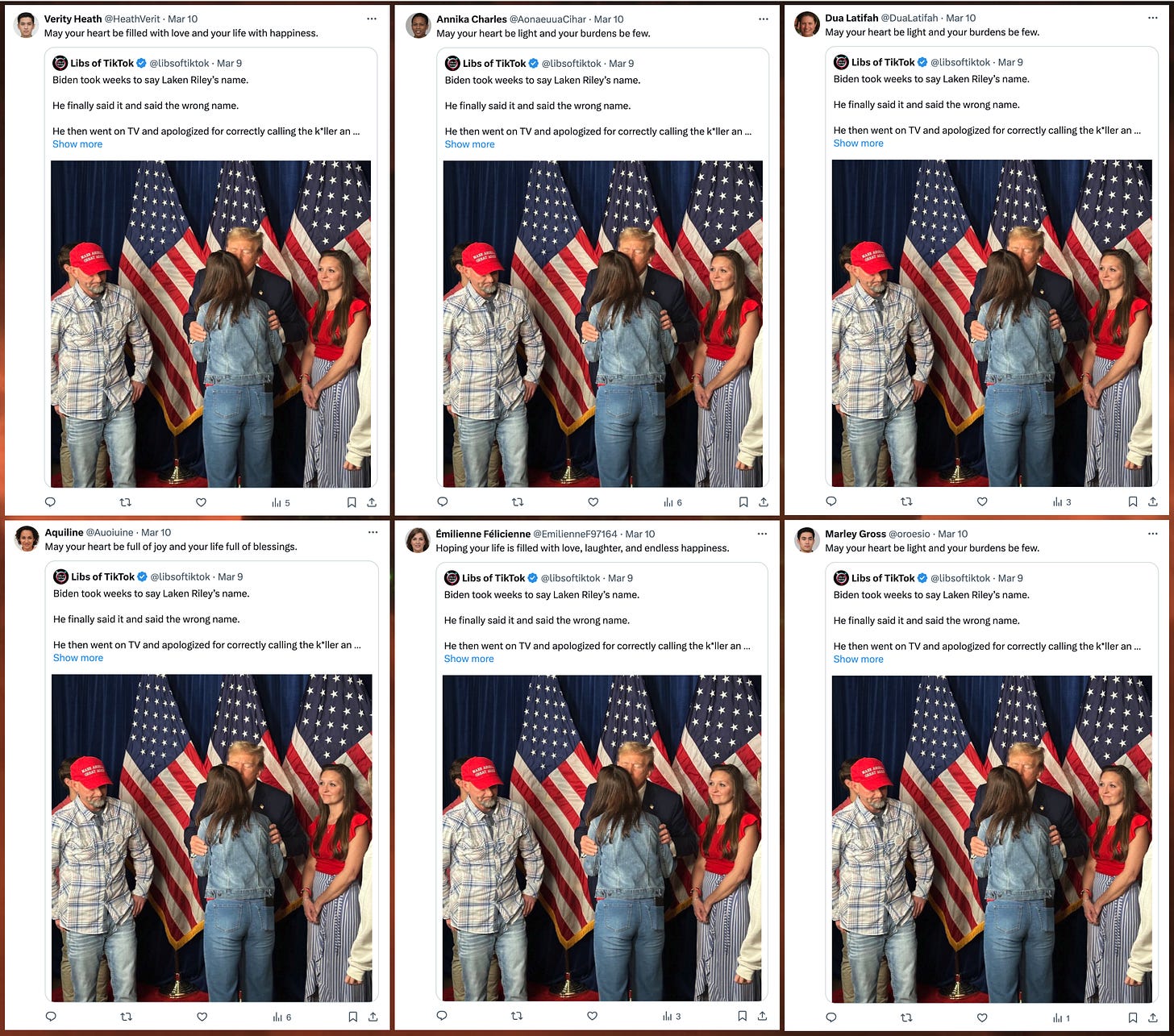Love, happiness, blessings, and spam
Sometimes inauthentic engagement is hard to spot, but this is not one of those times
Social media ads are generally greeted with more annoyance than enthusiasm even in the best of times, and it is therefore quite odd to see a large number of X (formerly Twitter) accounts quoting a Samsung Mobile ad with generic uplifting messages such as “may your days be filled with love, laughter, and sunshine”. Unsurprisingly, there are multiple signs that the accounts creating these posts are inauthentic, between the eerie similarity of the messages, the relatively recent creation dates, and the fact that many of the accounts use StyleGAN-generated faces as profile images. The spammy accounts in question do not limit their artificial amplification to Samsung posts; a variety of news, meme, and political accounts have benefitted from their astroturfy attention, including far-right influencer Libs of TikTok.
Once upon a time, mapping out this entire network of spam accounts would have been a relatively trivial task with the free Twitter REST API. Sadly, those days are gone, and researchers must resort to more cumbersome and error-prone methods to gather data on networks such as this one. Exploration of this network was accomplished simply by scrolling through the quote posts of multiple posts amplified by the spam accounts manually, saving the HTML, and parsing the account names and avatars in Python. This process was continued until it ceased yielding large batches of accounts that were not already in the dataset, and is unlikely to have resulted in a complete set of accounts or posts.

The manual data harvesting process yielded 813 spam accounts, created between May 2023 and February 2024. Many of these accounts have bizarre handles with unusually lengthy sequences of vowels, such as @rioaeeuieoa or @Miueuiiaoaaie. Almost all of the quote post spam generated by the accounts was posted on March 10th, 2024.
520 of the 813 accounts in this spam network (~64%) use GAN-generated faces as their profile images. Some, but not all, of these GAN-generated faces have StyleGAN watermarks in the lower right corner of the image. In a few cases, such as @ArieioeWiioteie, @cuojn30310, and @oaialiiisa, multiple accounts use the same GAN-generated face. The combination of GAN-generated faces and long strings of vowels in account names is a pairing of traits that this spam network shares with a now-suspended network of spam accounts that frequently described themselves as “politics enthusiasts”.
293 of the spam accounts do not use GAN-generated faces as avatars. Of these, 77 use X’s default profile image, while the rest use images of a variety of different types. As with the GAN-generated faces, these images are occasionally reused; for example, @DarceyFran89578, @JohnnieLak, and @TajaAlma all have the same profile photo. Most of the non-GAN-generated images can be found on various reverse image search engines, but they do not seem to have been plagiarized from any one specific source.
The network’s quote posts are highly repetitive, with identical text frequently being posted by multiple accounts. In addition to the exact duplication, the posts are all basically saying the same thing, with different combinations of words drawn from what appears to be a relatively limited pool: peace, love, happiness, sunshine, laughter, etc. Although it is possible these phrases were generated via means of a large language model, the output is consistent with substantially more primitive techniques such as Markov chain text generation.
The content amplified by this spam network is quite varied, and includes a mix of ads, sports, entertainment, news, and political content. The political content amplified is generally from right-wing accounts, such as YouTuber Benny Johnson and the aforementioned Libs of TikTok. The generic positive messages posted by the spam accounts frequently seem out of context when paired with the quoted posts (and stick out like a sore thumb if anyone scrolls through the engagement section), but they do increase the apparent amplification numbers, making the posts in question look more popular than they actually are.








